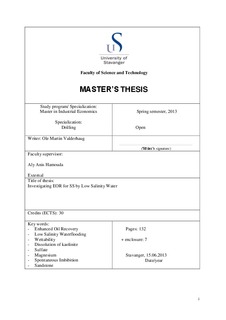| dc.description.abstract | Water flooding has for a very long time been used to improve oil recovery, in the recent years researchers have become aware of the effects from controlling the salinity and composition of the injected water. Low salinity water as a mean to improve oil recovery is now well established. Extensive research on crude oil/brine/rock (COBR) systems has shown that the injected water composition and salinity can acts as a tertiary recovery method by altering reservoir properties. However, due to the complexity of the COBR interactions, the mechanism(s) behind the low salinity EOR is still being discussed, and none of the suggested mechanisms has so far been accepted as a main process. In this work the intention is to contribute to the ongoing discussions.
This thesis contains a literature review, experimental and simulation works. The experimental part studies both core floods and spontaneous imbibition. Cores were flooded with low salinity brine, as well as brines containing only MgCl2 and only Na2SO4. The core floods was performed both as primary and secondary oil recovery method. Ion concentration, pH and pressure drop was measured during the flooding. After the flooding sequence the cores were re-saturated with oil and aged, spontaneous imbibition was then performed to observe the effects from the different brines.
Results from the experiments show that low salinity brine has several contributing mechanisms for enhanced oil recovery. Low salinity flooding is related to a wettability alteration towards more water-wet, by a mechanism that involves dissolution of clay and associated release of organic material and other fine material from pore surface, creating new initially water-wet surface.
The clay mineral kaolinite has a dissolution rate that is dependent upon pH, and injection of brines that increase the pH can cause an increased dissolution rate. Release of fines can lead to partial blocking of the pore throat, increasing the pressure drop. The proposed mechanism is supported by pH and pressure drop measurements, ion analysis, simulation, as well as spontaneous imbibition rate and final recovery results.
As a result oil recovery potential of low salinity appears to be sensitive to the rock and brine composition, and should therefore be evaluated for each case. | no_NO |
